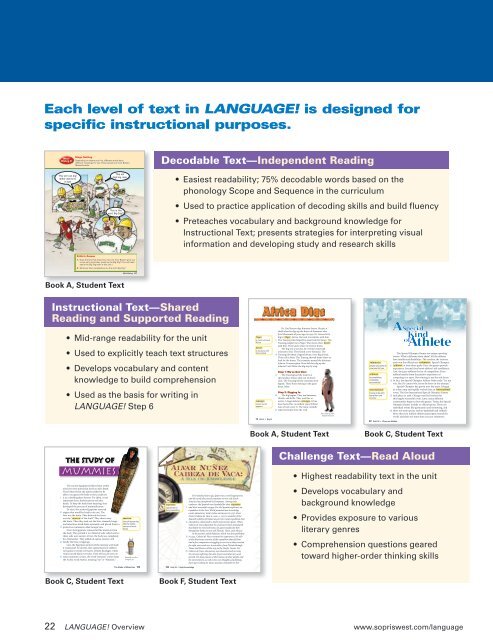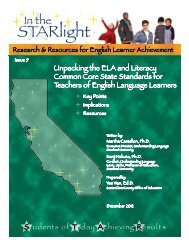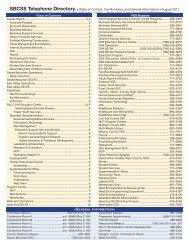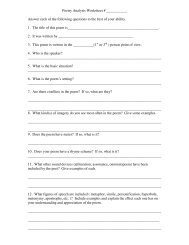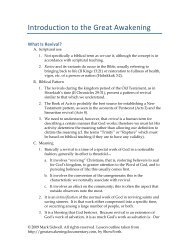4th Edition LANGUAGE! Overview
4th Edition LANGUAGE! Overview
4th Edition LANGUAGE! Overview
You also want an ePaper? Increase the reach of your titles
YUMPU automatically turns print PDFs into web optimized ePapers that Google loves.
Each level of text in <strong>LANGUAGE</strong>! is designed forspecific instructional purposes.Mini-Dialog 8Stage SettingDepending on where you live, different words havedifferent meanings for you. These people are from Boston,Massachusetts.Decodable Text—Independent ReadingThis ant can dig!What instinctsit has!This antdigs big, man.This is theants’ Big Dig!!!• Easiest readability; 75% decodable words based on thephonology Scope and Sequence in the curriculum• Used to practice application of decoding skills and build fluency• Preteaches vocabulary and background knowledge forInstructional Text; presents strategies for interpreting visualinformation and developing study and research skillsCritic’s Corner1. Does the fact that these two men are from Boston give youa clue as to what they mean by the Big Dig? (You will readabout the Big Dig later in this unit.)2. What are their perspectives on the ants’ Big Dig?Mini-Dialog 67Book A, Student TextInstructional Text—SharedReading and Supported Reading• Mid-range readability for the unit• Used to explicitly teach text structures• Develops vocabulary and contentknowledge to build comprehension• Used as the basis for writing in<strong>LANGUAGE</strong>! Step 6 Dr. Paul Sereno digs dinosaur bones. He gets athrill when he digs up the bones of dinosaurs wholived thousands of years ago. In 1997, Dr. Sereno led aNigerdig to Niger , Africa. He took 18 scientists with him.a country of west 5 The Touareg tribe helped his team look for bones. TheAfricaTouareg people live in Niger. They know their desertland best. They know where to look for bones.desertThe dig was a success. Dr. Sereno’s team hada dry place with a fantastic find. They found a new dinosaur. Thelittle rainfall10 Touareg told them a legend about a very big animal.They call it Jobar. The Touareg showed them where tolook for the bones. The scientists named the dinosaurJobaria. It means giant. How did they dig up theJobaria? Let’s follow the dig step by step.Step 1: Weʼve Got One!15 The Touareg lead the team to aspecial place. Bones stick out of desertrock. The Touareg tell the scientists theirlegend. These bones belong to the giantbeast, Jobar.Step 2: Digging In20 The dig begins. They use hammers,chisels, and drills. They work for 10emergesweeks. A huge skeleton emerges . It hascomes out of;been buried for 135 million years! Fifteenappearstons of rock cover it. The team carefully25 takes the bones from the rock.The Touareg tribehelped the team.76 Unit 3 • Dig It!Book A, Student TextThe Special Olympics Games are unique sportingevents. What’s different about them? All the athleteshave intellectual disabilities. The coaches, the trainers,volunteersand even the officials are volunteers . Special Olympicspeople who perform 5 achieves at least three goals. First, the games providea service for free experience. Second, they boost athletes’ self-confidence.Last, they give athletes the joy of competition. Everyachievesathlete benefits from the positive experience ofaccomplishes;competing in a sport. But winning is not the sole focus.completes10 In fact, the Special Olympics Athlete Oath reads: “Let mesuccessfullywin. But if I cannot win, let me be brave in the attempt.”Special Olympics has grown over the years. It beganinternational as a day camp and rapidly evolved into an internationalhaving to do with event. The first International Special Olympics Gamesmore than one 15 took place in 1968. Chicago was the first host forcountrythis hugely successful event. Later, many differentcommunities began to host the games. Today, the SpecialOlympics Games include 27 official sports. There areindividual events like gymnastics and swimming, and20 there are team sports, such as basketball and softball.More than two million athletes participate around theworld, and there are more than 700,000 volunteers.82 Unit 16 • Cheer an AthleteBook C, Student TextThe Study ofMummiesChallenge Text—Read Aloud• Highest readability text in the unitThe ancient Egyptians believed that withineveryone were spirits that lived on after death.They believed that the spirits needed to beable to recognize the body so they could use5 it as a dwelling place forever. For them, it wasimportant that a body be preserved afterdeath. To keep the body from decaying, theydeveloped the process of mummification.To start, the ancient Egyptians removed10 organs that would be hard to dry out. Thefirst was the brain. They believed the brainwas the “ marrow of the skull.” They threw awaythe brain. Then they took out the liver, stomach, lungs,and intestines, dried them separately, and placed them in15 protective containers called canopic jars.Next, the Egyptians removed all the moisture fromthe body. They packed it in a blend of salts called natron;these salts were sacred. At last, the body was completelydry, like leather. They added oil, spices, jewelry, and20 finally the linen wrappings.Last, the Egyptians protected the mummy and madeit waterproof. To do this, they spread layers of rubberytree gums or resins over layers of linen bandages. Theseresins turned black over time. They still can be seen on25 most mummies. In fact, the word “mummy” comes fromthe Arabic word mumia, meaning “tar” or “bitumen.”marrowthe soft tissue thatfills the hollowcenters of mostbonesPainted woodencanopic jar.expertisespecial skill indoing somethingFive hundred years ago, Spain was a world superpower,and the newly discovered continent we now call NorthAmerica lay unexplored by Europeans. Among earlyexplorers, the Spanish were heralded for their expertise5 and their successful voyages. For the Spanish explorers, anexpedition to the New World promised new knowledge,exotic adventures, land, riches, and power. In 1527, AlvarNuñez Cabeza de Vaca (c. 1490–c. 1557), a member of theSpanish nobility, left Spain as part of a royal expedition that10 intended to claim land in North America for Spain. WhenCabeza de Vaca departed, he could never have anticipatedthat before he returned home, his quest would take himthrough the lands we now call Florida, Texas, and Mexico.In his journal, titled Relación, which was first published15 in 1542, Cabeza de Vaca recounts his experiences. He tellsof the disastrous outcome of the expedition that left himand a few companions struggling to survive as they traveledfor eight years and over 6,000 miles, from Florida throughTexas and Mexico all the way to the Pacific Ocean. For20 Cabeza de Vaca, the journey was characterized not onlyby extreme suffering, but also by personal discovery andgrowth. His keen powers of observation of other people andhis environment, as well as his own thoughts and feelings,have kept Cabeza de Vaca’s journal a bestseller to this• Develops vocabulary andbackground knowledge• Provides exposure to variousliterary genres• Comprehension questions gearedtoward higher-order thinking skillsThe Study of Mummies 105182 Unit 34 • Seek KnowledgeBook C, Student TextBook F, Student Text22 <strong>LANGUAGE</strong>! <strong>Overview</strong> www.sopriswest.com/language


